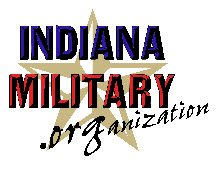|
Naming
of the streets |
|
Camp Atterbury is not
only a military installation, it is a Hoosier memorial. The east-west
streets are numbered by their position. The north-south streets are
named for great Hoosiers. Riley
Street - for James Whitcomb Riley, the world famous poet. Eggleston
Street - for Edward Eggleston, an author, with such titles
as "Roxy", "Hoosier Schoolmaster" and "The
Little Corporal" to his credit. Fairbanks
Street - for Charles Warren Fairbanks, vice-president for
Theodore Roosevelt in 1904. Harrison
Street - for William Henry Harrison, Governor of Indiana
and Indiana's only President. Kern
Street - for John W. Kern, Vice-Presidential candidate with
William Jennings Bryan. Owen
Street - for Richard Owen, Captain in the Mexican War and
Colonel in the 6th Indiana Regiment in the Civil War. Noble
Street - for James Noble, Indiana's first United States
Senator. Burnside
Street - for Ambrose E. Burnside, General in the Union
forces of the Civil War and leader of the Union in the Battle of
Fredericksburg. Durbin
Street - for Winfield T. Durban, soldier at the Battle of
Vicksburg and 1900 Governor of Indiana. Lawton
Street - for Henry Lawton, who tried to bring order to the
Philippines after the Spanish-American War. Ambushed and killed by an
angry group of natives. Taylor
Street - for Zachary Taylor, not from Indiana, but on
September 5th, 1812, his fast thinking saved Fort Harrison from being
burnt to the ground by the Indians. Gatling
Street - for Richard Jordan Gatling, inventor of the
Gatling Gun. Smith
Street - for Caleb Blood Smith, Indiana's first cabinet
member in Washington, D.C. Milroy
Street - for Robert H. Milroy, Captain of the 1st Indiana
Regiment in the Civil War, later Colonel of the 9th
Regiment and finally Major General. Anderson
Street - for William Anderson, Chief of the Delaware tribe. Pepper
Street - for Abel C. Pepper, Brigadier General in the
Militia, member of the Indiana General Assembly, Representative of
Dearborn County and U. S. Marshall of Indiana. Quinney
Street - for Austin E. Quinney, the Mohican Indian Chief.
Quinney brought his tribe to central Indiana from New York in the
early 1800's. Tippecanoe
Road - for early Indiana's most important battle, the
Battle of Tippecanoe. Mauxferry
Road - Not named after a Hoosier, but in existence for
hundreds of years, and one of the earliest roads in Indiana. The name
is derived from Mauck's Ferry from Mauckport in Harrison County and
ran to Indianapolis. In Indianapolis, the road is known today as
Madison Avenue. Indiana veteran's of the Mexican War marched homeward
along this road. |
|
As published in the "The Crier", 03/2012 Anderson - Named for William Anderson, a Chief of the Delaware Tribe and father-in-law of the Conner Prarie Founder. Burnside - named for Ambrose E. Burnside, Union general at the Battle of Fredericksburg. Clark - Named for George Rogers Clark, veteran of the Battle of Vincennes, 1779. Durbin - Named for Winfield T. Durbin, Civil War soldier and Governor of Indiana in 1900. Eggleston - Named for Edward Eggleston, Hoosier author of "Hoosier Schoolmaster" among others. Fairbanks - Named for Charles W. Fairbanks, vice president of Theodore Roosevelt, 1904. Gatling - named for Richard . Gatling, inventor of the repeating Gatling gun. Harrison - named for William H. Harrison, Indiana govenor and U. S president. Kern - named for John W. Kern, vice presidential candidate in 1908 from Indiana. Lawton - Named for Henry Lawton, killed in the Spanish-American War. Milroy - named for Robert H. Milroy, captain in the 1st Indiana Regiment in the Civil War. Noble - named for James Noble, Indiana's first U. S. Senator. Owen - named for Richard Owen, a colonel in the 16th Indiana Regiment in the Civil war. Quinney - named for Austin E. Quinney, a central Indiana Mohican Indian Chief in the early 1800s. Riley - named for Hoosier poet, James Whitcomb Riley. Smith - named for Caleb B. Smith, Indiana's first cabinet member in Washington, D. C. Taylor - named for Zachary Taylor, a captain in the Battle of Fort Harrison. Tippecanoe - named for Indiana's most important battle, the Battle of Tippecanoe. Hickman - named for LTC Horace M. Hickman, WW1 veteran of the Army Air Corps. McLlvaine - named for Francis McLlvanie, first officer from Indiana killed in action in WW1. Wilder - named for BG John T. Wilder, famous Civil War general of the "Lightning Brigade". Morton - named for Oliver Perry Morton, Indiana Civil War-era Governor. Ohio Ridge - named for the Ohio Ridge Church, the Lutheran founders from Ohio. 92nd Division - named for the 92nd Infantry Division, the Buffalo Soldiers. Georgetown - named for the road that went from Georgetown in Brown County, now named Bean Blossom. Mauxferry - named for the road from Mauck's Port Landing in Harrison County; a ferry was located there to cross the Ohio. Lincoln - named for Abraham Lincoln, U. S. president and boyhood resident of Indiana. Wallace - named for Indiana's sixth Governor, David Wallace. He also went on to become a Congressman. His son, Lew, wrote "Ben Hur". Tipton Trail - named for Maj John Tipton, veteran of the War of 1812, leader of the Indiana Rangers and a U. S. Senator. McGee Range - named for William D. McGee, of Indianapolis, WW2 veteran and Medal of Honor recipient. Woodfill Range - named for Samuel Woodfill, Bryantsburg resident, WW1 and WW2 veteran and Medal of Honor recipient in WW1. |
 Page last revised
10/21/2022 Page last revised
10/21/2022James D. West www.IndianaMilitary.org Host106th@106thInfDivAssn.org |